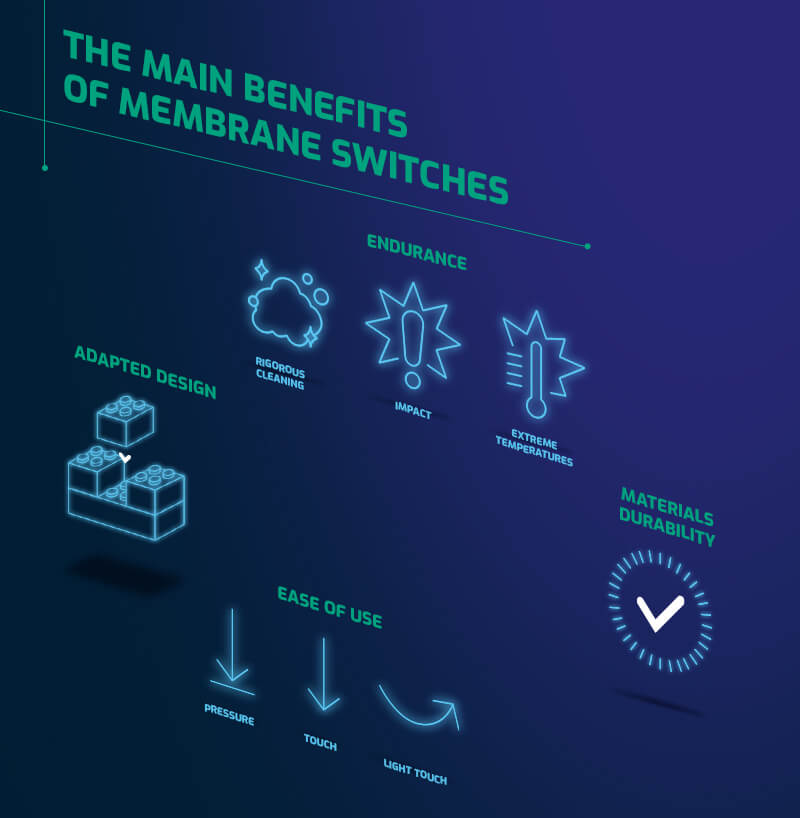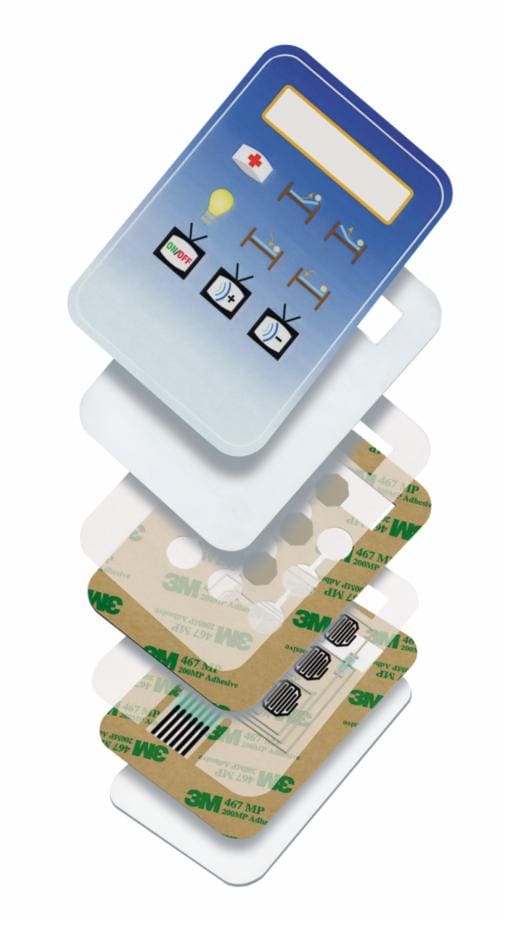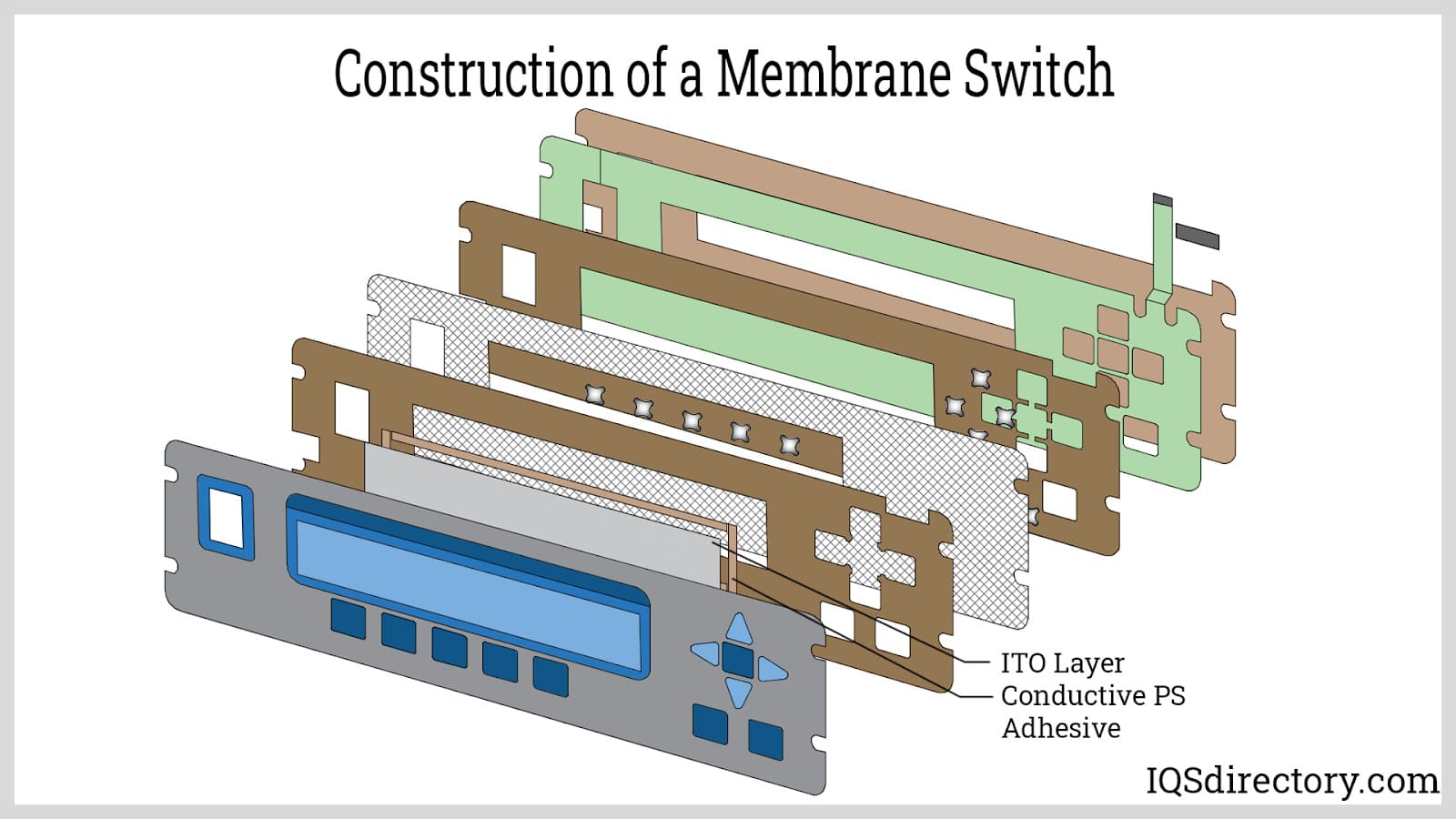The Production Refine Behind Membrane Switch Over: What You Need to Know
The production process behind membrane layer switches combines careful design, material choice, and quality control. It starts with recognizing the complexities of membrane button design and progresses through numerous stages, including product selections and printing techniques. Each stage plays an essential duty in making certain performance and resilience. Nonetheless, the intricacies of layer building and the rigorous testing requirements might disclose insights that are not quickly apparent. What exists past these foundational aspects?
Recognizing Membrane Switch Over Design
Membrane layer switches may appear easy at initial glimpse, their design involves intricate factors to consider that ensure capability and toughness. The design procedure begins with a comprehensive understanding of user needs, including the interface's desired application and environmental aspects. Functional designs is a crucial element, as the design must help with simplicity of use while making sure that tactile feedback meets customer expectations.Moreover, the layering of elements, such as graphic overlays, sticky layers, and conductive traces, need to be precisely crafted. membrane switch. This split arrangement not just influences the button's responsiveness but additionally influences its longevity. Interest is given to the securing methods utilized to secure versus moisture and dust, which can endanger performance. Additionally, style considerations encompass looks, where color pattern and aesthetic quality boost user experience. Ultimately, the style of membrane layer changes equilibriums capability, individual experience, and sturdiness, ensuring that they satisfy the needs of various applications efficiently
Products Used in Membrane Switch Manufacturing
When selecting materials for membrane button production, it is important to contemplate both performance and sturdiness. The main materials consist of polyester and polycarbonate films, which give flexibility and stamina. These films are usually coated with sticky to assure correct bonding to substratums. Conductive inks, normally composed of silver or carbon, are essential for developing electrical connections within the button, permitting dependable operation.Additionally, a safety layer, such as a difficult coat, is often put on boost scratch resistance and durability. The choice of backing material, such as acrylic or foam, can significantly influence the switch's responsive feeling and overall customer experience. Additionally, various ecological factors, including temperature level and moisture, must direct product choice to guarantee peak efficiency in certain applications. Inevitably, the appropriate mix of products adds to the membrane switch's capability and life-span, making informed choices essential for suppliers.
The Printing Process: Creating Graphics and Text
The printing process in membrane layer switch manufacturing plays a substantial role in producing premium graphics and message. Various graphic style methods are employed to guarantee aesthetic allure and capability, while careful ink option methods are important for longevity and efficiency. Recognizing these elements is fundamental for attaining best lead to membrane switch design.
Graphic Layout Techniques
Graphic design techniques play an important function in the printing process of membrane buttons, as they define how graphics and message will eventually show up on the last item. Reliable graphic layout involves the critical use typefaces, shades, and layouts to enhance readability and aesthetic appeal. Designers typically utilize vector graphics for scalability, making certain that images continue to be sharp at various sizes. Furthermore, focus to contrast and placement is important, as it affects customer communication and aesthetic high quality. The unification of branding elements, such as logos, should be handled with like maintain brand name stability. On the whole, thoughtful graphic style strategies contribute significantly to the functionality and beauty of membrane layer buttons, influencing individual experience and product performance.
Ink Option Techniques
Picking the suitable ink is vital for achieving the preferred aesthetic quality and durability in membrane switch manufacturing. Numerous ink types are utilized, consisting of solvent-based, water-based, and UV-curable inks. Each kind supplies distinct features, such as resistance, adaptability, and attachment to environmental elements. Solvent-based inks are typically favored for their sturdiness and dynamic colors, while water-based inks are much more ecologically friendly yet may have restrictions in attachment. UV-curable inks offer rapid treating and robust performance. Additionally, color matching strategies ensure that the selected inks align with layout specifications. Eventually, the option of ink should think about factors such as application method, substrate compatibility, and end-use needs to accomplish exceptional cause membrane button graphics and message.
Layer Building And Construction and Assembly

Material Choice Process
A mindful selection of materials is crucial in the manufacturing process of membrane layer buttons, as it directly affects capability and sturdiness. The main products used consist of polyester, polycarbonate, and various conductive inks. Polyester is frequently preferred for its excellent resistance to chemicals and abrasion, making it ideal for harsh atmospheres. Polycarbonate, on the other hand, offers exceptional clearness and impact resistance, which is helpful for applications needing visibility and robustness. Conductive inks, commonly made up Visit This Link of silver or carbon, are vital for developing trustworthy electrical pathways. In addition, the option of adhesive materials influences the general stability of the switch - membrane switch. Reviewing variables such as environmental exposure, responsive feedback, and visual needs overviews manufacturers in choosing the most effective materials for their details applications
Layer Attachment Strategies
Sticking layers in membrane layer switch construction is a crucial procedure that ensures functionality and longevity. Different attachment methods are employed to secure excellent bonding in between layers, which generally consist of the use of adhesives, warm, and pressure. Pressure-sensitive adhesives (PSAs) are generally used for their ease of application and instant bonding capabilities. Additionally, thermal bonding methods can be used, where heat is made use of to trigger glue residential or commercial properties, securing a strong bond. The option of adhesion approach greatly depends on the materials included and the certain application demands of the membrane layer switch. Appropriate placement and uniform application of adhesives are vital to prevent issues, protecting the switch runs effectively throughout its intended life-span.
High Quality Control Procedures
Ensuring quality assurance throughout the layer building and assembly of membrane switches is vital for maintaining performance and reliability. This procedure commonly includes numerous crucial actions, consisting of thorough assessments at each phase of manufacturing. Manufacturers make use of sophisticated testing methods, such as peel tests and bond assessments, to confirm the integrity of layer bonds. Furthermore, aesthetic examinations are carried out to identify any problems in printing or product incongruities. Environmental problems, such as temperature and humidity, are carefully kept track of to guarantee excellent healing and bond. Moreover, regular calibration of devices assists maintain accurate production requirements. By carrying out these quality control measures, producers can substantially lower the risk of product failing, ensuring that the final membrane switches over satisfy the needed specs and consumer expectations.
Examining and Quality Assurance Measures

Developments in Membrane Layer Switch Over Technology
As innovations in technology continue to advance, membrane layer buttons are gaining from cutting-edge advancements that boost their functionality and customer experience. One notable innovation is the combination of capacitive touch modern technology, which allows for more receptive and intuitive interface. This shift not just improves visual appeals but also decreases mechanical deterioration, expanding the life-span of the switches.Additionally, advancements in visuals overlay materials have brought about enhanced toughness and resistance to environmental elements such as wetness and UV light. These products now supply boosted quality and illumination, additional raising the visual appeal.Furthermore, the consolidation of wise modern technology is transforming membrane switches right into interactive control board, enabling connectivity with IoT tools. This connectivity fosters a seamless customer experience, leading the means for applications in different sectors, from medical care to consumer electronic devices. Jointly, these innovations placement membrane layer switches as vital components in contemporary device layout.
Often Asked Questions
The length of time Does the Membrane Layer Switch Over Manufacturing Process Take?
The duration of the membrane layer button manufacturing procedure can differ significantly. Factors such as intricacy, products used, and manufacturing quantity influence timelines, with typical production varying from a few days to numerous weeks for conclusion.
What Are the Common Applications for Membrane Buttons?
Membrane layer buttons are frequently made use of in various industries, including automobile controls, household home appliances, clinical tools, and consumer electronics (membrane switch). Their adaptability and resilience make them perfect for applications requiring easy to use interfaces and reputable performance in diverse environments
Can Membrane Switches Over Be Customized for Particular Needs?

What Is the Lifespan of a Normal Membrane Change?
The lifespan of a regular membrane button varies, however usually, it varies from 1 to 5 million cycles. Aspects such as use, atmosphere, and material high quality considerably affect resilience and overall performance with time.

Are Membrane Layer Switches Over Eco-friendly?
The environmental kindness of membrane switches differs. Some materials used might not be recyclable, while others can be environment-friendly. The total impact relies on producing practices and materials, demanding careful consideration throughout choice and disposal. The production procedure behind membrane switches over combines careful design, material choice, and high quality control. It starts with recognizing the complexities of membrane layer button design and proceeds with different phases, consisting of product choices and printing strategies. When selecting products for membrane button production, it is crucial to ponder both efficiency and resilience. A cautious choice of materials is necessary in the production procedure of membrane buttons, as it directly influences performance and sturdiness. The option of bond approach greatly depends on the products included and the particular application check my blog demands of the membrane button.